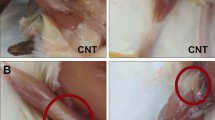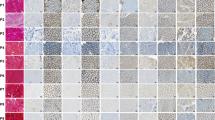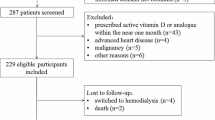Abstract
The high prevalence of obesity at an early stage of Duchenne muscular dystrophy (DMD) could result not solely from reduced physical activity, but may also involve low resting energy expenditure (REE), abnormal nutrient utilization, or overfeeding. We hypothesized that the dramatic muscle mass loss in DMD should reduce the REE. REE was measured by indirect calorimetry in 13 9-13-y-old DMD boys (5 obese, 8 nonobese) and 9 male age-matched controls. Muscle mass was estimated from 3-d creatinine excretion in urine. Daily energy intake was estimated from 7-d diet records. In the nonobese DMD group (NODMD) the muscle mass was reduced by 71%, and the REE was 13% lower than in controls(47.5 versus 54.6 kcal·h-1, p < 0.05). Postabsorptive respiratory quotients appeared higher in both DMD groups than in the controls; however, the difference was significant only for the NODMD group (0.88 versus 0.83, p < 0.05). Respiratory quotients were not different between the two DMD groups. Diet records were not contributive in revealing a different dietary behavior between groups. Our results suggest that: 1) muscle mass loss in DMD is associated with a low REE, 2) low postabsorptive fat utilization might occur at an early stage of the disease, and 3) obesity is not associated with an increase in fat utilization in DMD. This study warrants further research to test low REE and low fat utilization as risk factors in developing obesity in DMD.
Similar content being viewed by others
Log in or create a free account to read this content
Gain free access to this article, as well as selected content from this journal and more on nature.com
or
Abbreviations
- DMD:
-
Duchenne muscular dystrophy
- REE:
-
resting energy expenditure
- ODMD:
-
obese DMD
- NODMD:
-
nonobese DMD
- Vo2:
-
oxygen consumption
- Vco2:
-
carbon dioxide production
- RQ:
-
respiratory quotient
- FFM:
-
fat-free mass
References
Griffiths RD, Edwards RHT 1988 A new chart for weight control in Duchenne muscular dystrophy. Arch Dis Child 63: 1256–1258
Willig TN, Carlier L, Legrand M, Rivière H, Navarro J 1993 Nutritional assessment in Duchenne muscular dystrophy. Dev Med Child Neurol 35: 1074–1082
Ravussin E, Swinburn BA 1992 Pathophysiology of obesity. Lancet 340: 404–408
Ravussin E, Lillioja S, Knowler WC, Christin L, Freymond D, Abbott WGH, Boyce V, Howard BV, Bogardus C 1988 Reduced rate of energy expenditure as a risk factor for body-weight gain. N Engl J Med 318: 467–472
Zurlo F, Lillioja S, Esposito-Del Puente A, Nyomba BL, Raz I, Saad MF, Swinburn BA, Knowler WC, Bogardus C, Ravussin E 1990 Low ratio of fat to carbohydrate oxidation as predictor of weight gain: study of 24-h RQ. Am J Physiol 259:E650–E657
Froidevaux F, Schutz Y, Christin L, Jéquier E 1993 Energy expenditure in obese women before and during weight loss, after refeeding, and in the weight-relapse period. Am J Clin Nutr 57: 35–42
Weir JB 1949 New method for calculating metabolic rate with special reference to protein metabolism. J Physiol 109: 1–9
Schaeffer F, Georgi M, Zieger A, Schärer K 1994 Usefulness of bioelectric impedance and skinfold measurements in predicting fat-free mass derived from total body potassium in children. Pediatr Res 35: 617–624
Lukaski HC 1987 Methods for the assessment of human body composition: traditional and new. Am J Clin Nutr 46: 537–556
1991 Centre informatique sur la qualité des aliments. Répertoire général des aliments. Tables de composition. Editions Médicales Internationales Lavoisier, Paris
Zurlo F, Larson K, Bogardus C, Ravussin E 1990 Skeletal muscle metabolism is a major determinant of resting energy expenditure. J Clin Invest 86: 1423–1427
Thomson WHS, Sweetin JC 1974 The neurogenic and myogenic hypotheses in human (Duchenne) muscular dystrophy. Nature 249: 151–152
Edmonds CJ, Smith T, Griffiths RD, Mackenzie J, Edwards RHT 1985 Total body potassium and water, and exchangeable sodium, in muscular dystrophy. Clin Sci 68: 379–385
Griggs RC, Forbes G, Moxley RT, Herr BE 1983 The assessment of muscle mass in progressive neuromuscular disease. Neurology 33: 158–165
Elia M 1992 Energy Metabolism: Tissue Determinants and Cellular Corollaries. Raven Press Ltd, New York, pp 61–79
Ravussin E, Bogardus C 1989 Relationship of genetics, age, and physical fitness to daily energy expenditure and fuel utilization. Am J Clin Nutr 49: 968–975
Bandini LG, Schoeller DA, Dietz WH 1990 Energy expenditure in obese and non obese adolescents. Pediatr Res 27: 198–203
Maffeis C, Pinelli L, Schutz Y 1995 Increased fat oxidation in prepubertal obese children: a metabolic defense against further weight gain?. J Pediatr 126: 15–20
Ravussin E, Burnand B, Schutz Y, Jequier E 1982 Twenty-four-hour energy expenditure and resting metabolic rate in obese, moderately obese, and control subjects. Am J Clin Nutr 35: 566–573
Rennie MJ, Edwards RHT, Millward DJ, Wolman SL, Halliday D, Matthews DE 1982 Effects of Duchenne muscular dystrophy on muscle protein synthesis. Nature 296: 165–167
Roberts SB, Savage J, Coward WA, Chew B, Lucas A 1988 Energy expenditure and intake in infants born to lean and over-weight mothers. N Engl J Med 318: 461–466
Smith PEM, Calverley PMA, Edwards RHT, Evans GA, Campbell EJM 1987 Practical problems in the respiratory care of patients with muscular dystrophy. N Engl J Med 316: 1197–1205
Flatt JP 1987 Dietary fat, carbohydrate balance, and weight maintenance: effects of exercise. Am J Clin Nutr 45: 296–306
Gazzaniga JM, Burns TL 1993 Relationship between diet composition and body fatness, with adjustment for resting energy expenditure and physical activity, in preadolescent children. Am J Clin Nutr 58: 21–28
Bandini LG, Schoeller DA, Cyr HN, Dietz WH 1990 Validity of reported energy intakes in obese and non obese adolescents. Am J Clin Nutr 52: 421–425
Author information
Authors and Affiliations
Rights and permissions
About this article
Cite this article
Hankard, R., Gottrand, F., Turck, D. et al. Resting Energy Expenditure and Energy Substrate Utilization in Children with Duchenne Muscular Dystrophy. Pediatr Res 40, 29–33 (1996). https://doi.org/10.1203/00006450-199607000-00006
Received:
Accepted:
Issue date:
DOI: https://doi.org/10.1203/00006450-199607000-00006
This article is cited by
-
Serum creatinine as a biomarker for dystrophinopathy: a cross-sectional and longitudinal study
BMC Neurology (2021)
-
Genetic reduction of the extracellular matrix protein versican attenuates inflammatory cell infiltration and improves contractile function in dystrophic mdx diaphragm muscles
Scientific Reports (2020)
-
Body composition and energy expenditure in Duchenne muscular dystrophy
European Journal of Clinical Nutrition (2003)



